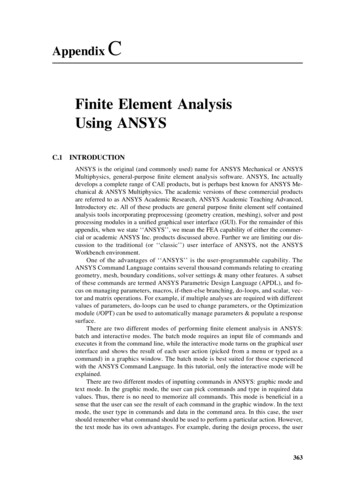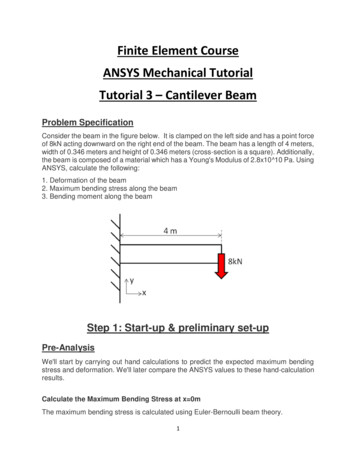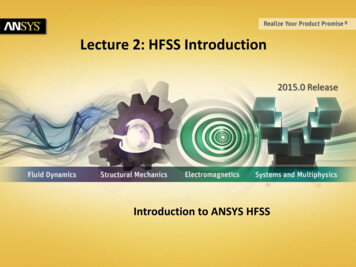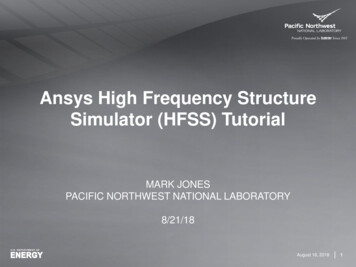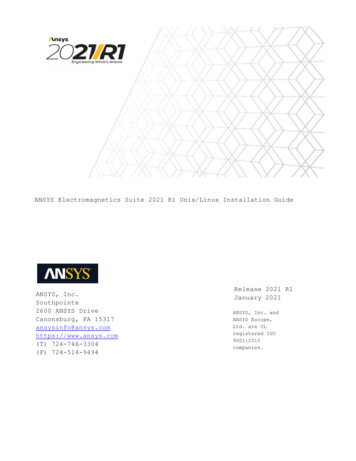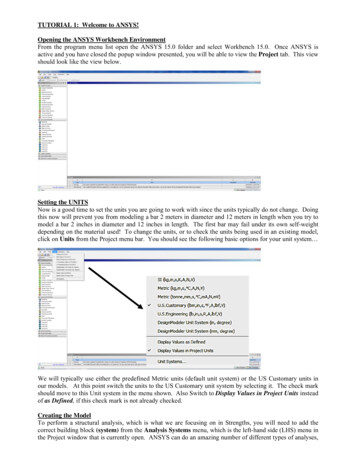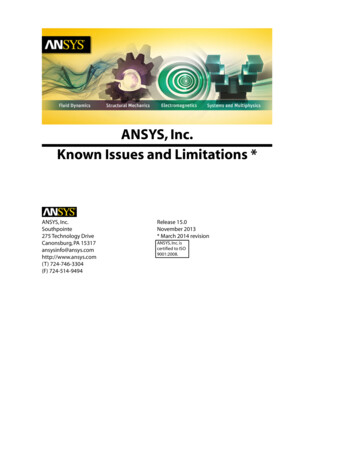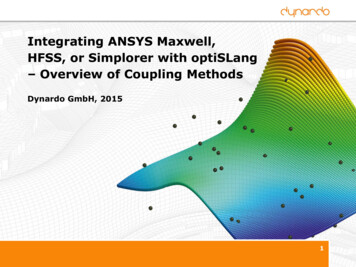
Transcription
Integrating ANSYS Maxwell,HFSS, or Simplorer with optiSLang– Overview of Coupling MethodsDynardo GmbH, 20151
Dynardo GmbHIntroHow can simulation projects in Maxwell/HFSS/Simplorer beinvestigated with optiSLang? ANSYS Workbench can be the integrator Maxwell/HFSS/Simplorer simulations can be coupled directly via text filescontaining simulation inputs and outputs Depending on the coupling method, various benefits can be realized: Simultaneous execution and parallelization signal processing outside Maxwell/HFSS/Simplorer encapsulation and automatized reproduction of complex workflowsaiinvolving multiple programs and tools In the following slides only ANSYS Maxwell is mentioned but theintegration with HFSS and Simplorer is equivalentIntegrating ANSYS Maxwell, HFSS, or Simplorerwith optiSLang – Overview of Coupling Methods2
Dynardo GmbHProcess Integration: Maxwell & optiSLangA) optiSLang inside WorkbenchB) Direct integration via text filesC) Large-Scale DSOIntegrating ANSYS Maxwell, HFSS, or Simplorerwith optiSLang – Overview of Coupling Methods3
Dynardo GmbHProcess Integration: Maxwell & optiSLangA) optiSLang inside WorkbenchB) Direct integration via text filesA2) Workbench inside optiSLangC) Large-Scale DSOIntegrating ANSYS Maxwell, HFSS, or Simplorerwith optiSLang – Overview of Coupling Methods4
Dynardo GmbHMethod A: Using ANSYS WorkbenchIn Maxwell Make input and output variables accessiblefrom the Workbench Parameter SetinputparameteroutputparameterDesignXplorer is the vessel forcommunicating parameters betweenthe WB Parameter Set and Maxwell.Integrating ANSYS Maxwell, HFSS, or Simplorerwith optiSLang – Overview of Coupling Methods5
Dynardo GmbHMethod A: Using ANSYS WorkbenchFeatures WB multi-physics The Workbench Parameter Set cantreat only scalar output variables Simultaneous design evaluation viaPython update script and DSOThe optiSLang inside ANSYS plug-incan be used in two ways: optiSLang systems can be createdin the Workbench A WB project can be represented asWB node in the optiSLang GUIIntegrating ANSYS Maxwell, HFSS, or Simplorerwith optiSLang – Overview of Coupling Methods6
Dynardo GmbHMethod B: scripting and ASCII files (direct coupling)Maxwell Batch job including Python script Write transient reports into files signal data accessibleoptiSLang Text-based batch job node Extract signal data with ETK Signal data free mathematicalcomputations inside any optiSLangsystemSimultaneous computation: optiSLang spawns Maxwell batch jobsIntegrating ANSYS Maxwell, HFSS, or Simplorerwith optiSLang – Overview of Coupling Methods7
Dynardo GmbHMethod C: Scripted Large-Scale DSOLarge-Scale DSO simultaneous batch computation with little overhead Large-Scale DSO is a special feature of Maxwell/HFSS/Simplorer No limitation to the degree of parallelism (tasks & cores) Powerful interface for flexible construction of job structures Independent jobs with separate result folders containing traces as text files In optiSLang the full power of the LS-DSO interface can be leveraged Python scripts collect the designs, trigger the jobs, and redistribute the datainto the design folders where optiSLang can find the data with ETK Jobs stay in the background; jobs can be distributed over the networkIntegrating ANSYS Maxwell, HFSS, or Simplorerwith optiSLang – Overview of Coupling Methods8
Dynardo GmbHProcess Integration: Maxwell & optiSLangA) optiSLang inside Workbench Straightforward wizards extendthe WB-environment Simultaneous design solutionpossible via DSO if only scalaroutputs are investigatedB) Direct integration via text files The OSL full version offers thefreedom to build manifold customworkflows (nested systems,performance maps, ) Straightforward parallelizationusing multiple Maxwell instances Signal analysisA2) Workbench node in OSL Power of WB: multi-physics(and convenience) Power of OSL: freedom todefine complex workflowsC) Large-Scale DSO Enables signal analysis incombination with simultaneousdesign evaluation via OptimetricsDSO Designs of one iteration of anyOSL algorithm are bundled intoone single LS-DSO job Simulation in backgroundIntegrating ANSYS Maxwell, HFSS, or Simplorerwith optiSLang – Overview of Coupling Methods9
Dynardo GmbHCombined Integrations optiSLang’s process integration enables the combination of differentparallel or sequential solvers in one workflowTutorial: Help/Tutorials/Workflows/KursaweIntegrating ANSYS Maxwell, HFSS, or Simplorerwith optiSLang – Overview of Coupling Methods10
Dynardo GmbHNested Systems Nested systems allow for nested-loop analyses such as coupled RDOTutorial: Help/Tutorials/Oscillator/Oscillator RobustnessIntegrating ANSYS Maxwell, HFSS, or Simplorerwith optiSLang – Overview of Coupling Methods11
Dynardo GmbHHow to get startedWe will tailor the plan that suits you best Pilot projects: training & collaborative problem solving on site;accompanying consulting hours for assistance in data interpretation knowhow transfer, and workflow extension Training: Training schedule at www.dynardo.de We offer individual trainings Introductory webinars (see website) Support: e-Mail: support@dynardo.com phone: 49 – 3643 – 9008 - 32Integrating ANSYS Maxwell, HFSS, or Simplorerwith optiSLang – Overview of Coupling Methods12
signal processing outside Maxwell/HFSS/Simplorer encapsulation and automatized reproduction of complex workflows aiinvolving multiple programs and tools In the following slides only ANSYS Maxwell is mentioned but the integration with HFSS and Simplorer is equivalent


